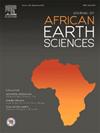埃及沙漠东南部Homrit Mukpid地区埃迪卡拉纪岩浆侵入岩的岩石学约束:大块岩石地球化学和矿物学
IF 2.2
4区 地球科学
Q2 GEOSCIENCES, MULTIDISCIPLINARY
引用次数: 0
摘要
本研究全面探讨了Homrit Mukpid (HM)花岗质套的演化和岩石成因,强调了其岩石学特征。HM花岗岩主要包括两套:较老的花岗闪长岩套(GHM)和较年轻的碱长石花岗岩套(AHM)。与AHM相比,GHM中TiO2、MgO、CaO、Fe2O3、Sr、Ba、Cr、V和Sc的富集显著,而Ta、Th、Rb、Y、Nb、Sn、Ga、U、Pb、Zn和∑REEs的富集较低。地球化学上,GHM以显著的负P、负Ti和负Nb异常为特征,hree(平均≈11 ppm)相对于lree(平均≈83 ppm)减少,Eu(平均≈Eu/Eu * = 0.78)为中等负Eu异常(平均≈Eu/Eu * = 0.78),具有实质分异、俯冲相关的i型岩浆源特征。AHM则表现出较高的SiO2(平均≈75 wt%)、总碱(平均≈9 wt%)、FeO/MgO和Rb含量。稀土元素模式显示出强烈的负Eu异常(Eu/Eu∗≈0.08)和hree富集,表明其为碰撞后a2型花岗岩。重要的是,没有证据表明使用lambda和Irber方法确定了m型四分体效应。根据花岗质岩石的矿物学和地球化学资料推断,HM作为阿拉伯努比亚盾的一部分,其演化具有明显的碰撞和碰撞后阶段。GHM由俯冲的板块脱水形成,促进了上地幔的熔融,提供了高钾基熔体的底板。GHM的形成归因于俯冲板块的脱水,引发上地幔熔融,产生高钾基性熔体。该熔体随后在高温(平均≈809℃,使用锆石饱和温度)下进行熔融和分馏。相反,AHM通过板块剥离形成,引起软流圈上升流和富含调性/粘土的变长岩的熔融,随后在低温(平均≈784℃)和浅深度的碰撞后伸展期间发生极端的分离结晶过程。本文章由计算机程序翻译,如有差异,请以英文原文为准。
Petrological constraints of the Ediacaran magmatic intrusions, Homrit Mukpid area, southeastern Desert, Egypt: Bulk rock geochemistry and mineralogy
The study provides a comprehensive investigation into the evolution and petrogenesis of the Homrit Mukpid (HM) granitic suites, emphasizing their petrological characteristics. The HM granitic rocks comprise two main suites: the older granodioritic suite (GHM) and the younger alkali-feldspar granite suite (AHM). The GHM exhibits notable enrichment in TiO2, MgO, CaO, Fe2O3, Sr, Ba, Cr, V, and Sc, and lower concentrations of Ta, Th, Rb, Y, Nb, Sn, Ga, U, Pb, Zn, and ∑REEs compared to the AHM. Geochemically, GHM is distinguished by pronounced negative P, Ti, and Nb anomalies, as well as a decrease in HREEs (avg. ≈ 11 ppm) relative to LREEs (avg. ≈ 83 ppm) and a moderately negative Eu anomaly (avg. ≈ Eu/Eu∗ = 0.78), characteristic of substantially fractionated, subduction-related I-type magmatic sources. In contrast, the AHM displays high SiO2 (avg. ≈ 75 wt%), total alkalis (avg. ≈ 9 wt%), and higher FeO/MgO, and Rb contents. Their REEs pattern shows a strong negative Eu anomaly (av. Eu/Eu∗ ≈0.08) and HREEs enrichment, indicative of post-collisional A2-type granites. Importantly, there is no evidence of M-type tetrad effect, as determined using both the lambda and Irber methods. The evoultion of the HM, as a part of the Arabian Nubian Shield, is marked by distinct stages of collision and post-collision, as inferred from the mineralogical and geochemical data of granitic rocks. The GHM is formed from the subducted slab dehydrating, which facilitated the melting of the upper mantle, providing underplating of high K-mafic melts. The GHM formation is attributed to the dehydration of a subducted slab, which triggered upper mantle melting and the generation of high-K mafic melts. This melt subsequently underwent melting and fractionation at elevated temperatures (avg. ≈ 809 °C, using zircon saturation temperature). Conversely, the AHM formed through slab delamination, inducing asthenospheric upwelling and the melting of tonalitic/clay-rich metapelite rocks, followed by extreme fractional crystallization processes during a post-collisional extension episode at low temperatures (avg. ≈ 784 °C) and shallow depths.
求助全文
通过发布文献求助,成功后即可免费获取论文全文。
去求助
来源期刊

Journal of African Earth Sciences
地学-地球科学综合
CiteScore
4.70
自引率
4.30%
发文量
240
审稿时长
12 months
期刊介绍:
The Journal of African Earth Sciences sees itself as the prime geological journal for all aspects of the Earth Sciences about the African plate. Papers dealing with peripheral areas are welcome if they demonstrate a tight link with Africa.
The Journal publishes high quality, peer-reviewed scientific papers. It is devoted primarily to research papers but short communications relating to new developments of broad interest, reviews and book reviews will also be considered. Papers must have international appeal and should present work of more regional than local significance and dealing with well identified and justified scientific questions. Specialised technical papers, analytical or exploration reports must be avoided. Papers on applied geology should preferably be linked to such core disciplines and must be addressed to a more general geoscientific audience.
 求助内容:
求助内容: 应助结果提醒方式:
应助结果提醒方式:


